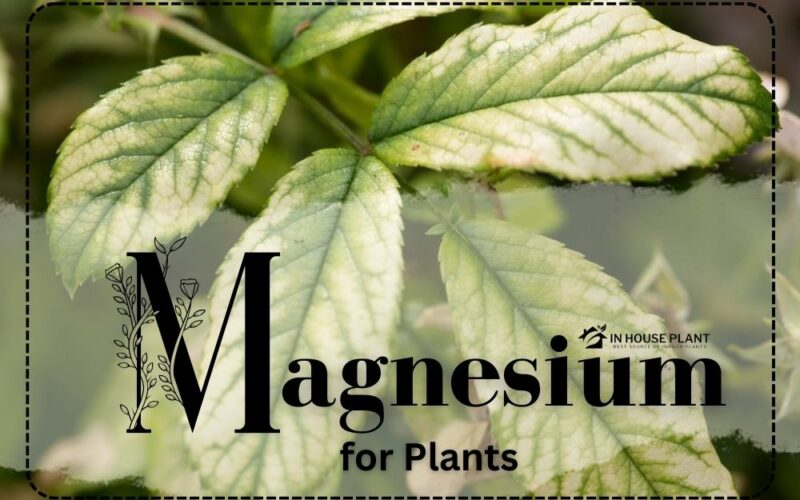Plants for growth and development need various nutrients. Magnesium is one of them. In this post, you will find out what is magnesium for plants and why it is important.
I will tell you about the different functions of Mg and after reading this post, you find out what happens for plants with Magnesium deficiency. Keep reading.
➡ You can also hear the audio version of this article.
What Is Magnesium for Plants?

Magnesium (Mg) is the eighth element on Earth that is also an essential macronutrient for plants. Do you know what macronutrients are?
Macronutrients such as Mg are nutrients that plants require for their growth and development in large amounts.
Macronutrients include Nitrogen (N), phosphorus (P), Potassium (K), Calcium (Ca) Magnesium (Mg), and Sulfur (S). Hence, the plants for their healthy growth must take relatively large quantities of Mg from the soil.
I’m a horticultural counsellor (I have a PhD in plant protection- Phytopathology). People often ask me “You said Mg is a Macronutrient, so we must fertilize the plant with a Magnesium fertilizer?”
No, no, no, as I told you above, in terms of frequency, Mg is the eighth element on Earth. Since your plant can take enough amount of it from the soil. However, several factors can cause Magnesium deficiency in plants. For example, acidic sandy soils have a few amounts of Mg.
Sometimes the soil has a good quantity of magnesium but the plant cannot absorb it. For instance, the extra amount of some nutrients such as P and N will decrease or even inhibit Magnesium absorption by plants’ roots.
So, you must fertilize your plant only when:
- You have spotted the symptoms of Magnesium deficiency. I discussed it in my other post, “Is magnesium good for plants?” and especially for some plants such as “Palm trees” and “Blueberry plants”.
- Some factors can cause Magnesium deficiency in your plants and you want to prevent them. I recommend reading my other post “How to Prevent Magnesium Deficiency in Plants”. There, you can find more details about causal agents of Mg deficiency in plants and practical solutions to fix them.
After you found out what is magnesium for plants, now let’s dig into why magnesium is important for plants, in other words, what does Mg do in your plant?
Why Magnesium Is Important for Plants?
Magnesium plays a crucial role in plant physiology. In the following you can find out some of its main functions in plants:
Chlorophyll and Photosynthesis
If you are still thinking about what is magnesium for plants? Look at the below picture, it’s a chlorophyll molecule. You see a Magnesium element in its centre. Do you know what is chlorophyll? Have you ever wondered why plants are green? It’s due to chlorophyll molecules. Let’s tell you its story to find out the importance of Mg for your plant.

The chlorophyll molecules in the leaves of plants are factories to produce food (Carbohydrates) with water and CO2 which is called “Photosynthesis”. The necessary energy for this process is provided by sunlight. But how chlorophyll can capture the energy of sunlight?
As I told you above, an Mg element is in the centre of every chlorophyll. Magnesium is responsible for capturing the energy of sunlight. In a light spectrum, Mg absorbs almost all wavelengths near blue and red and reflects green light. So, you see the plants green.
So, Magnesium is the core of the chlorophyll structure and without it, your plant cannot produce chlorophyll and cannot do photosynthesis.
There are thousands of chlorophylls in every plant cell, hence your plant needs a large amount of Mg and it’s the reason Magnesium is a Macronutrient. Without sufficient magnesium, your plant will turn yellow (chlorosis) and weak.
Enzyme activation
Come on to find out another answer to the question “What is magnesium for plants?” As you know all of the plant metabolism and physiological processes in plant (and animal) cells are performed by molecules called enzymes. For example, energy production, DNA and protein synthesis, and nutrient metabolism.
Magnesium is present in the structure of a wide range of enzymes within plant cells to stabilize their structures. Magnesium also is involved in activating enzymes by facilitating enzyme-substrate interactions. So, to have a healthy plant, you must provide a good source of Mg for it.
ATP production

Plants for doing every metabolic process need energy and you may be shocked if I tell you there is a molecule in cells that plays a role similar to currency (indeed energy currency) in plant cells.
This magic molecule is Adenosine triphosphate (ATP) and Magnesium ions are required for the synthesis and utilization of ATP.
Protein synthesis
Come on to get to know another macromolecule in cells: Ribosome. The ribosome is similar to a Knitting machine that creates chains of amino acids to synthesize proteins. Magnesium ions are involved into:
- Ribosome assembly
- Stability of ribosomes
- Facilitating the binding of transfer RNA (tRNA) to ribosomes.
Nutrient uptake and transport

Please look at the below picture, plant roots uptake water and nutrients from the soil and transfer them to leaves by their vessels (xylems). The leaves uptake Co2 from the air by tiny pores (stomata) on their surface and produce food (carbohydrates) in chlorophylls. The food is transferred to roots and other parts by another type of vessel that is called phloem.
But what power causes the transport of water and essential nutrients within plant vessels against the force of gravity? the opening and closing of stomata regulate gas exchange and water loss that affects the movement of water and nutrients through the plant. Magnesium plays a crucial role in proper stomatal function.
Conclusion
Overall, if I want to answer “What is magnesium for plants?” I must respond magnesium is a crucial ion for vital activities in your plant such as photosynthesis, enzyme activities, ATP production, protein synthesis, and nutrient uptake and transfer.
Hence, to have healthy and green plants, it is crucial to provide sufficient magnesium levels in the soil and ensure your plant can absorb adequate Mg for its development and growth.

Elahe Rabiei
Hi, I’m Elaheh. My Academic major is plant protection, and houseplants are my expertise. As a houseplant lover, my house is full of indoor plants and it is my passion to take care of them. Hence, I’m here to share my knowledge and experience about growing healthy houseplants. I am also a plant protection advisor, so feel free to ask me any questions you may have.

